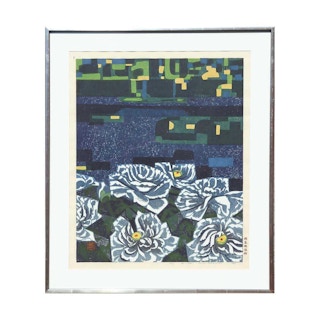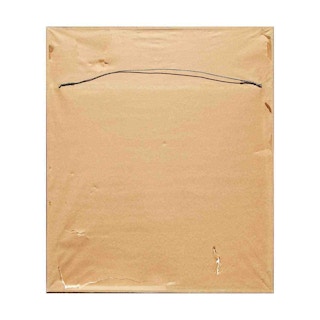Material
Woodcut Print
About
Abstract blue and yellow toned Japanese floral landscape titled "Morning (Peonies)". Signed, titled, dated, and editioned (19/50) by the artist at the bottom of the print. The print is currently matted and framed.
Artist Biography
Hashimoto was born in 1899 in the Tottori Prefecture, a southern region of the main island of Honshu. Having spent most of his life as the assistant principal of the first girls’ high school in Tokyo, it was his life’s work as a printmaker that has made him a beloved figure of Japanese art history. Hashimoto graduated in 1924 after studying to become an art teacher, specializing in watercolours. Around the same time, he attended Hiratsuka Un’ichi’s short course in woodblock painting, the practice that would produce his most recognizable work. Hashimoto was welcomed into Un’ichi’s circle of artists and friends, the Yoyogi group, an iconic group of woodblock printmakers working in the sōsaku-hanga style, also known as “creative prints”. But it wasn’t until Hashimoto encountered Un’ichi that his definitive style began to emerge. Under his tutelage, Hashimoto would produce the quintessentially Japanese woodcut prints for which he is today most well known. Traditionally, Japanese woodcut prints were made via a process of collaboration between carver, printer, artist, and eventual publisher. The sōsaku-hanga movement adopted western ideals about artistic autonomy and creative integrity. Woodcut printmakers like Hashimoto insisted on the artist’s involvement in the process from inception of the idea all the way through to making the cut and print. Western influences are visible in the work itself with Hashimoto making prints that deviated from traditional Japanese woodcuts. While Un’ichi’s prints are far more muted, Hashimoto’s bold use of color is his signature trait. Even so, the cultural values of traditional Japan are very much alive in Hashimoto’s prints, depicting Japanese temples and gardens that are as iconic as they are sublime. Hashimoto also dabbled in figure studies, and even these reflect the tranquility and beauty of Japanese zen traditions. Prior to the twentieth century and the beginnings of photography, woodblock prints were very much a commercial proposition in Japan. Hashimoto was part of the movement that sought to revitalize Japanese printmaking by embracing global influences that had trickled into Japan during the Meiji period, while maintaining a firm sense of place, and a clear affection for the most splendid parts of his home country.
Dimensions With Frame
H 31.75 in. x W 26.75 in. x D 1.25 in.
Dimensions Without Frame
H 25 in. x W 21 in.

